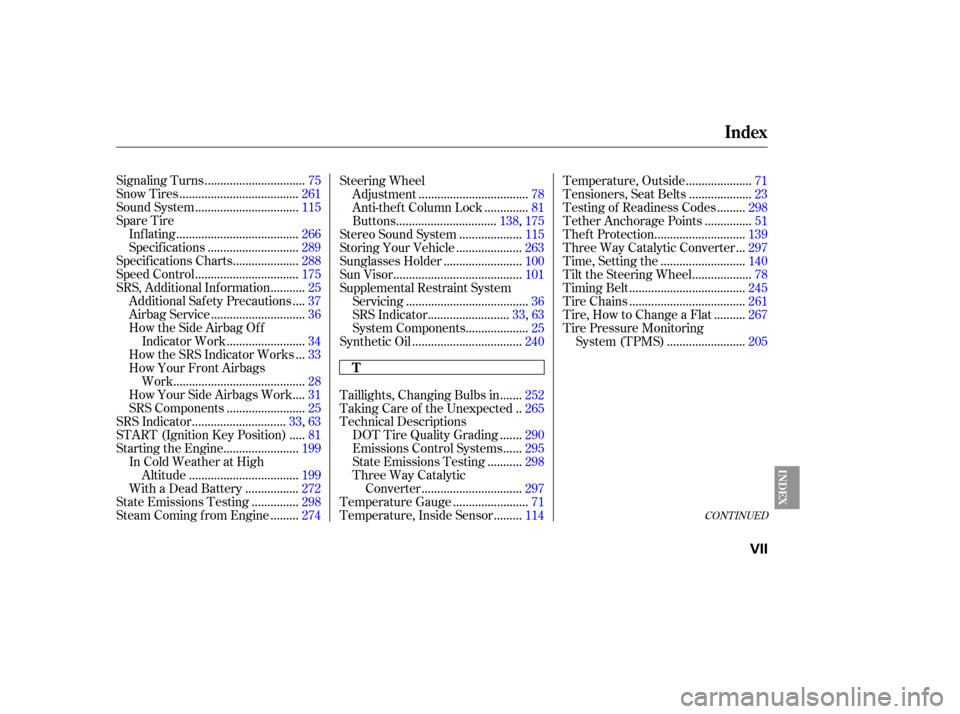sensor HONDA PILOT 2007 1.G Owner's Manual
[x] Cancel search | Manufacturer: HONDA, Model Year: 2007, Model line: PILOT, Model: HONDA PILOT 2007 1.GPages: 319, PDF Size: 4.53 MB
Page 209 of 319

The appropriate tire indicator and
low tire pressu re indicator comes on
if a tire becomes significantly
underinflated. See
on page .
This indicator comes on and stays on
if there is a problem with the tire
pressure monitoring system.
If you see this message, the system
is off and is not monitoring the tire
pressures. Have the system checked
by your dealer as soon as possible.
If you have a flat tire, the low tire
pressu re and tire monitor indicators
will come on. Replace the indicated
flat tire with the compact spare tire
(see page ). Each wheel is equipped with a tire
pressure sensor mounted inside the
tire behind the valve stem. You must
use TPMS specif ic wheels. It is
recommended that you always have
your tires serviced by your dealer or
qualif ied technician.
Af ter you replace the f lat tire, the
low tire pressure indicator stays on.
This is normal; the system is not
monitoring the spare tire pressure.
Manually check the spare tire
pressure to be sure it is correct.
Never use a puncture-repairing agent
in a f lat tire. If used, you will have to
replace the tire pressure sensor.
Havetheflattirerepairedbyyour
dealer as soon as possible.
266 205
As required by the FCC:
This device complies with Part 15 of theFCC rules. Operation is subject to thef ollowing two conditions: (1) This devicemay not cause harmf ul interf erence, and(2) this device must accept anyinterf erence received, includinginterf erence that may cause undesiredoperation.
Changes or modif ications not expresslyapproved by the party responsible f orcompliance could void the user’sauthority to operate the equipment.
This device complies with IndustryCanada Standard RSS-210.Operation is subject to the f ollowing twoconditions: (1) this device may not causeinterf erence, and (2) this device mustaccept any interf erence that may causeundesired operation of the device.
Tire Pressure Monitoring System (TPMS)
Tire Pressure Monitor
Low Tire
Pressure Indicator
Changing a T ire with T PMS Tire Pressure Monitoring
System (T PMS) Indicator
206
Page 299 of 319

The exhaust emissions controls
include f our systems: PGM-FI,
ignition timing control, exhaust gas
recirculation, and three way catalytic
converter. These f our systems work
together to control the engine’s
combustion and minimize the
amount of HC, CO, and NOx that
come out the tailpipe. The exhaust
emissions control systems are
separate f rom the crankcase and
evaporative emissions control
systems.
The PGM-FI system uses sequential
multiport f uel injection.
It has three subsystems: air intake,
engine control, and f uel control. The
powertrain control module (PCM)
uses various sensors to determine
how much air is going into the
engine. It then controls how much
f uel to inject under all operating
conditions.The emissions control systems are
designed and certif ied to work to-
gether in reducing emissions to
levels that comply with the Clean Air
Act. To make sure the emissions
remain low, you should use only new
Honda replacement parts or their
equivalent f or repairs. Using lower
qualitypartsmayincreasethe
emissions f rom your vehicle.
The emissions control systems are
covered by warranties separate from
the rest of your vehicle. Read your
warranty manual for more informa-
tion.
The three way catalytic converter is
in the exhaust system. Through
chemical reactions, it converts HC,
CO, and NOx in the engine’s exhaust
to carbon dioxide (CO ), nitrogen
(N ), and water vapor. This system constantly adjusts the
ignition timing, reducing the amount
of HC, CO, and NOx produced.
The exhaust gas recirculation (EGR)
system takes some of the exhaust
gas and routes it back into the intake
manif old. Adding exhaust gas to the
air/f uel mixture reduces the amount
of NOx produced when the f uel is
burned.
2
2
Exhaust Emissions Controls Replacement Parts
PGM-FI Syst emT hree Way Cat alyt ic Convert er
Ignit ion T iming Cont rol Syst em
Exhaust Gas Recirculat ion (EGR)Syst em
Emissions Cont rols
296
Page 316 of 319

CONT INUED
...............................
Signaling Turns .75
.....................................
Snow Tires .261
................................
Sound System .115
Spare Tire
......................................
Inf lating .266
............................
Specif ications .289
....................
Specif ications Charts .288
................................
Speed Control .175
..........
SRS, Additional Inf ormation .25
...
Additional Safety Precautions .37
.............................
Airbag Service .36
How the Side Airbag Of f
........................
Indicator Work .34
..
How the SRS Indicator Works .33
How Your Front Airbags
.........................................
Work .28
...
How Your Side Airbags Work .31
........................
SRS Components .25
.............................
SRS Indicator . 33, 63
....
START (Ignition Key Position) .81
.......................
Starting the Engine .199
In Cold Weather at High ..................................
Altitude .199
................
With a Dead Battery .272
..............
State Emissions Testing .298
........
Steam Coming f rom Engine .274 Steering Wheel
..................................
Adjustment .78
.............
Anti-theft Column Lock .81
...............................
Buttons . 138, 175
...................
Stereo Sound System .115
....................
Storing Your Vehicle .263
........................
Sunglasses Holder .100
........................................
Sun Visor .101
Supplemental Restraint System
......................................
Servicing .36
.........................
SRS Indicator .33,63
...................
System Components .25
..................................
Synthetic Oil .240
......
Taillights, Changing Bulbs in .252
.
Taking Care of the Unexpected .265
Technical Descriptions
......
DOT Tire Quality Grading .290
.....
Emissions Control Systems .295
..........
State Emissions Testing .298
Three Way Catalytic
...............................
Converter .297
.......................
Temperature Gauge .71
........
Temperature, Inside Sensor .114 ....................
Temperature, Outside .71
...................
Tensioners, Seat Belts .23
........
Testing of Readiness Codes .298
..............
Tether Anchorage Points .51
............................
Thef t Protection .139
..
Three Way Catalytic Converter .297
..........................
Time, Setting the .140
..................
Tilt the Steering Wheel .78
....................................
Timing Belt .245
....................................
Tire Chains .261
.........
Tire, How to Change a Flat .267
Tire Pressure Monitoring
........................
System (TPMS) .205
Index
INDEX
T
VII